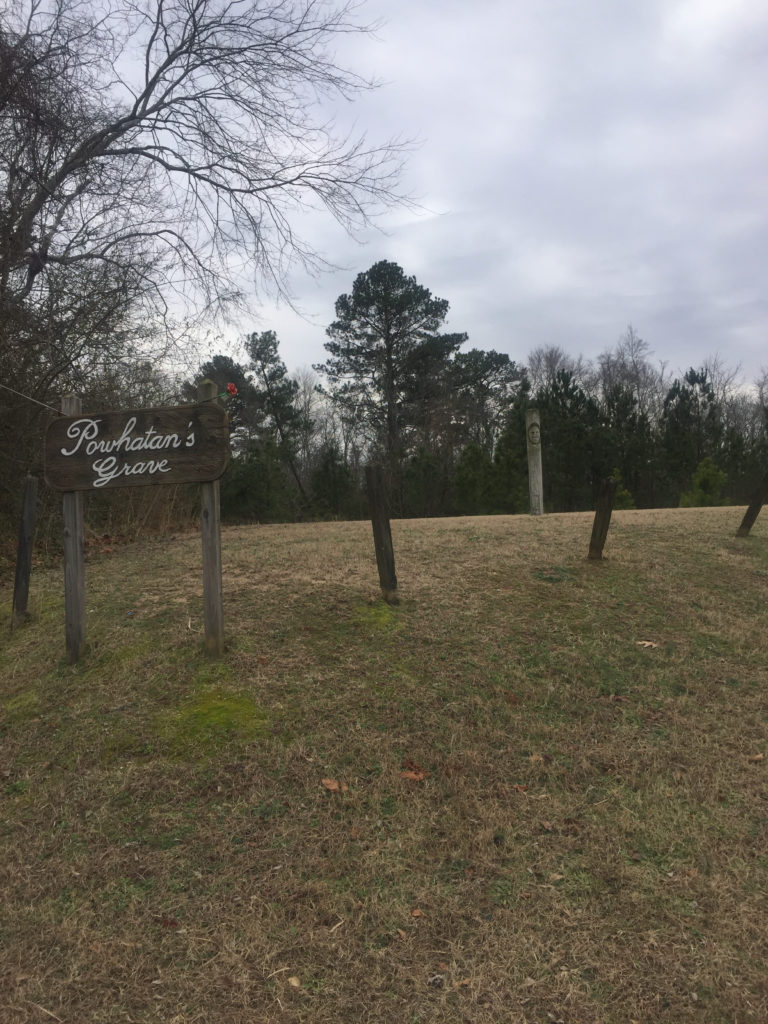Erik Visits an American Grave, Part 770
This is the grave of Powhatan.

Born in approximately 1547 in the Virginia tidewater, we know very little of the first sixty years of his life. His actual name was Wahunsenacawh and it was the English who called him Powhatan because that was one of the names of the Algonquin speaking peoples for whom he was one of the leaders. The English could never get past the idea that a tribal chieftain was not like a king but rather part of a collective. So they assumed Powhatan was the singular leader of these people when they invaded his lands in 1607. He seems to have a been a general leader of between four and six tribes, with the center of his power near modern Richmond. He was a very effective leader and was able to create what is today known as the Powhatan Confederacy, an alliance of about 30 tribes with perhaps upwards of 15,000 people.
Then the English came. This was a disaster for every Native person, even if they didn’t realize it at first. They should have killed every last European they found, driving them into the ocean. But who knew what would happen at the time. The English were shockingly violent though from the very beginning. People who had learned how to fight subjecting the Irish through sheer brutality were not going to treat people they saw as savages any differently.
When the English arrived, it didn’t take long for Powhatan and the other tribes to see them both as possibility and threat. What they probably wanted most of all was to trade with them while keeping them under control. Soon after the English landing, John Smith was captured by Opechancanough, Powhatan’s brother and another leader of his people. Smith later claimed that Pocahontas, actual name Matoaka, begged her father Powhatan to save him. This is almost certainly Smith making it up. He didn’t report this until 1624 and he had written plenty about his adventures before this. Some scholars believe that whatever ceremony there was likely was some sort of adoption into the tribe. In any case, Powhatan did not kill Smith, which was probably a big mistake.
In 1609, there was enough trade that Smith had his men build an English-style house for Powhatan, but there was always tension, to the point that Smith held Powhatan at gunpoint at one point in order to stop an ambush against him. Powhatan moved his base of operations around to avoid the English and to where the Pamunkey Reservation is today in 1611. By this time, there was full-fledged war between the English and Powhatan’s people, the so-called Anglo-Powhatan War, which took place off and on between 1610 and 1614. This included the worst kind of brutality by the English against women and children–rape, shooting children after throwing them overboard into the river, ritual executions. Powhatan didn’t have much of a response to this and because of this mostly lost his leadership of his people to Opechancanough, who was much more aggressive with the English genocidal murderers. It was only when the English captured Powhatan and held her for ransom that the war mostly ended, leading to Pocahontas’ marriage to John Rolfe.
In 1622, Opechancanough launched an attack to eliminate the English entirely, the second Anglo-Powhatan War. It damn near worked, as they killed about 1 out of every 4 English colonists in one day, 347 people in total. More would have died too if Christianized Indians under the English spell hadn’t given away the plot and warned leaders in Jamestown. In truth, the only successful revolt against European colonization turned out to be the Pueblo Revolt in New Mexico, which freed them from Spanish control between 1680 and 1692 and the Hopis until American occupation in 1848. By this time however, Powhatan was already dead. He probably died in 1618, at around 70 years of age.
Powhatan is buried on the Pamunkey Indian Reservation, King William County, Virginia. Opechancanough moved the remains to this mound himself. One can I suppose question if Powhatan is really buried under here after over 400 years of erosion and colonization. But we might as well believe it, both to respect Pamunkey culture and because who really knows if anyone buried is really there.
This is the first grave post from my recent visit to the South and I hope it is one you think is worthwhile. If you would like this series to visit other Native leaders, you can donate to cover the required expenses here. Blackhawk is in Selma, Iowa and Sitting Bull is probably in Fort Yates, North Dakota. Previous posts in this series are archived here.


